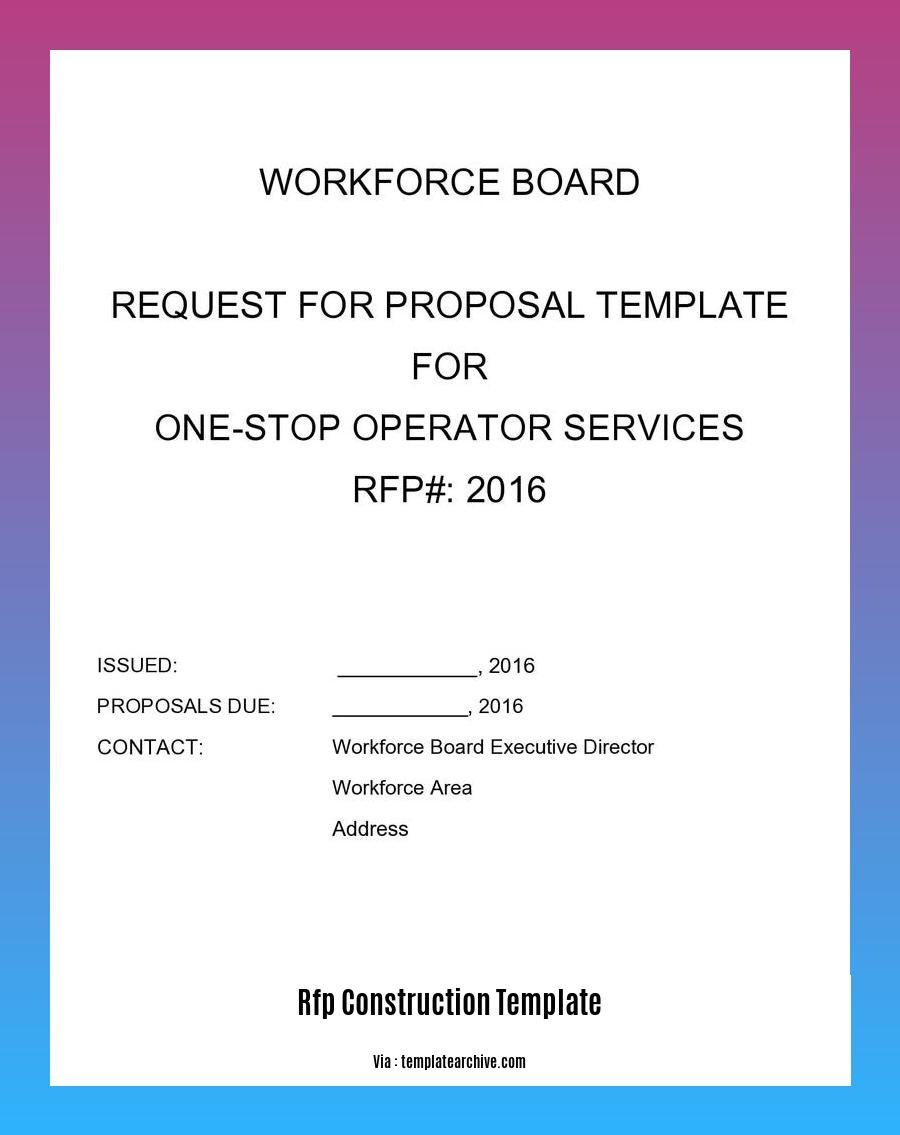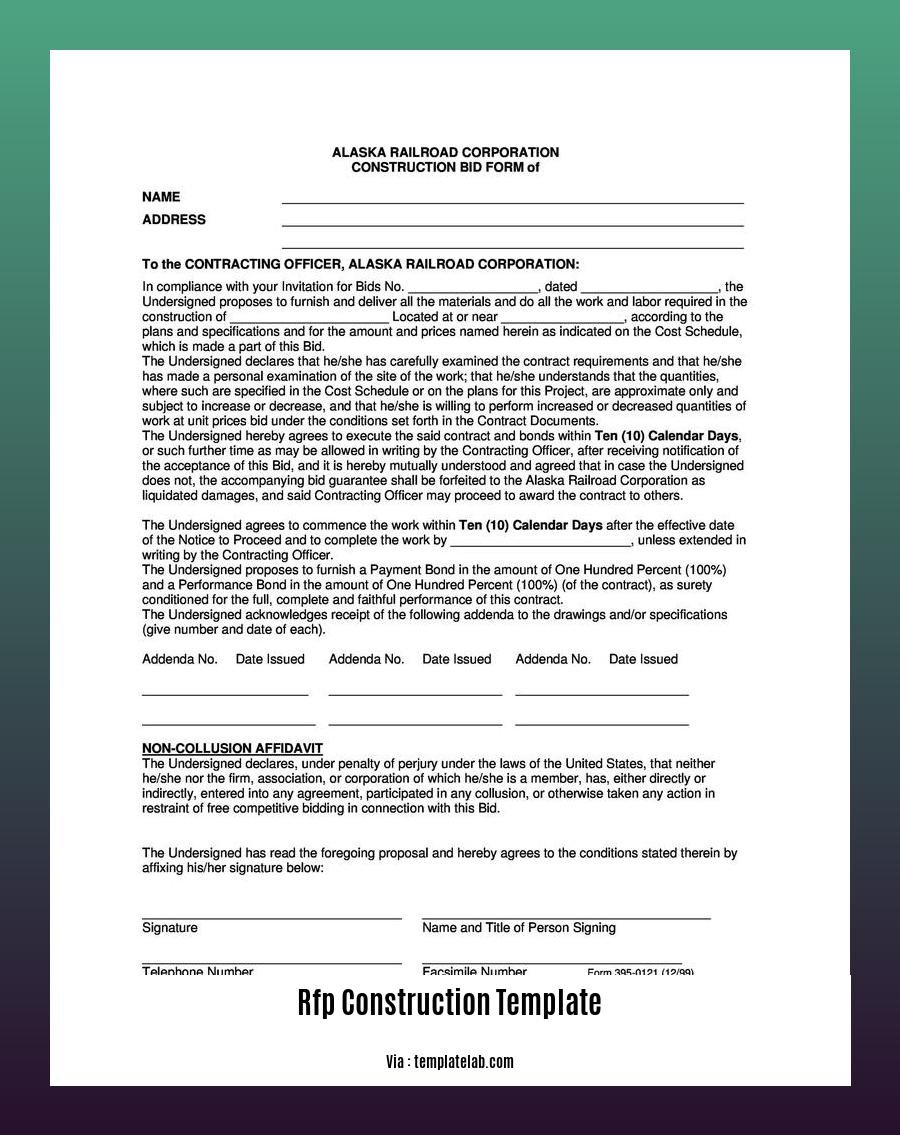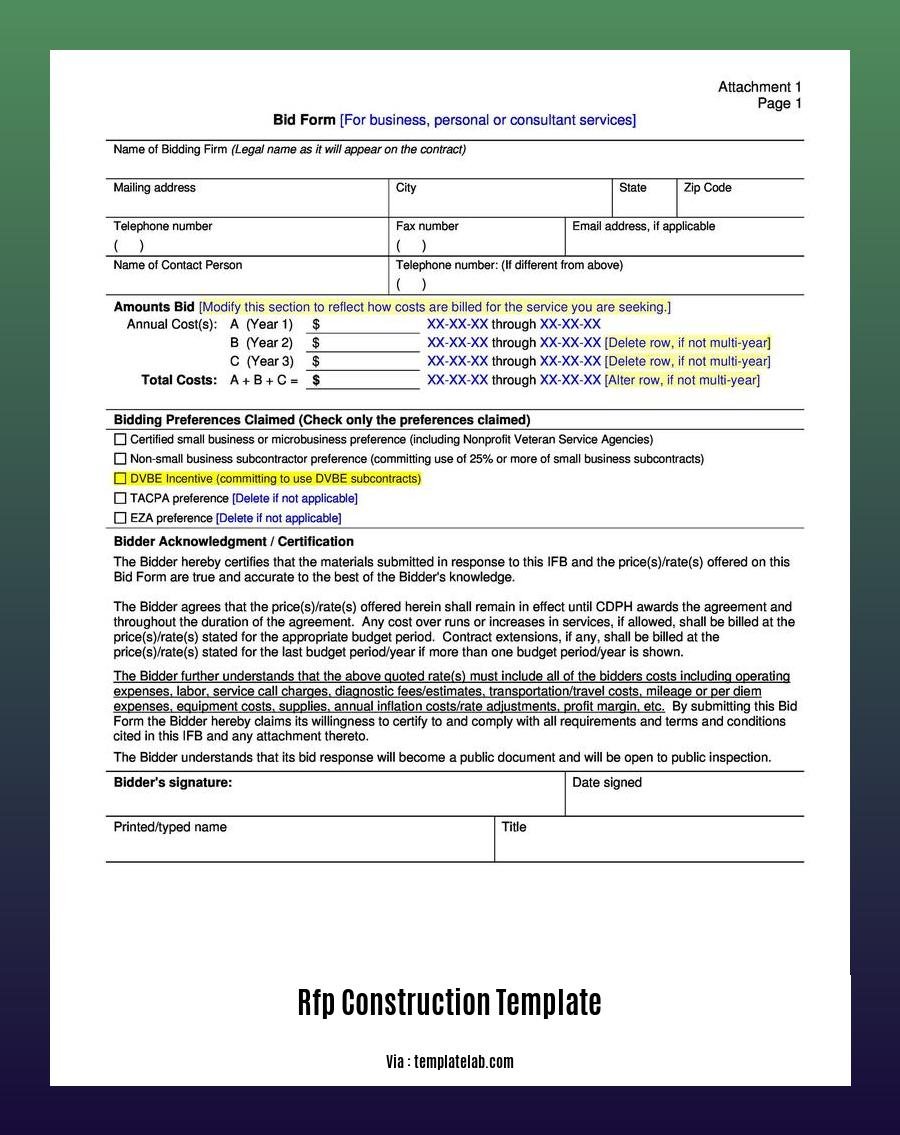Welcome to “RFP Construction Template: A Guide to Effective Procurement,” the ultimate resource for construction professionals seeking to master the art of RFP creation and evaluation. This comprehensive guide will equip you with the knowledge and tools necessary to develop high-impact RFPs that streamline the procurement process, attract the best contractors, and ensure project success.
Key Takeaways:
- An RFP in construction is a document that outlines project requirements and solicits contractor proposals.
- RFPs help project owners define objectives, contractors showcase capabilities, and ensure fair bidding.
- The RFP process involves preparation, issuance, proposal submission, evaluation, and contractor selection.
- Project management software can streamline RFP processes, create professional documents, and automate evaluations.
- General contractors use RFPs to select specialty contractors for specific projects.
- RFPs typically include sections on project background, scope of work, evaluation criteria, submission requirements, and contract terms.
RFP Construction Template: A Guide to Effective Procurement

A well-crafted Request for Proposal (RFP) is essential for efficient and successful construction projects. It clearly outlines the project requirements, invites qualified contractors to submit proposals, and establishes a fair bidding process.
To ensure your RFP construction template is effective, follow these steps:
Step 1: Define Project Scope and Objectives
Clearly define the project’s goals, scope of work, timeline, and budget. This sets the foundation for a successful RFP and helps contractors understand your project’s expectations.
Step 2: Gather Proposal Information
Identify the essential information contractors must provide in their proposals, such as project plans, cost estimates, references, and insurance details. Provide clear instructions on the submission format and deadline.
Step 3: Establish Evaluation Criteria
Determine the criteria you will use to evaluate proposals. Consider factors such as experience, qualifications, pricing, and project approach. Clearly state these criteria in the RFP so contractors can tailor their proposals accordingly.
Step 4: Use Clear and Concise Language
Use professional and concise language to describe the project and requirements. Avoid technical jargon that may not be familiar to all contractors.
Step 5: Review and Revise
Once you have drafted the RFP, thoroughly review it for clarity, completeness, and accuracy. Seek feedback from colleagues or industry experts to ensure it effectively communicates your project needs.
By following these steps, you can create an effective RFP construction template that attracts qualified contractors, streamlines the bidding process, and helps you select the best contractor for your project.
Gain insights into preparing a successful Request for Proposal for construction projects by exploring our detailed example here: request for proposal construction example.
Uncover strategies to maximize your construction profits by learning how to effectively rake in construction.
Ace your DBQ assignment with the comprehensive reconstruction dbq answer key that provides expert guidance.
Expand your vocabulary by understanding the meaning of “reconstruction” in Bengali.
Enrich your knowledge of the word “reconstruction” by exploring its interpretation in Tamil.
Stay informed about the industry practices regarding retention fees in construction to ensure proper financial management.
Streamlining the Procurement Process with Customized Templates

Key Takeaways:
- Clarity and Structure: Templates provide a clear and structured framework for requests, ensuring consistent information from vendors.
- Time-Saving Efficiency: Streamlined templates reduce the time and effort required for procurement activities.
- Improved Collaboration: Consistent templates facilitate effective communication among project stakeholders.
- Enhanced Accuracy: Pre-defined fields and guidelines minimize errors and ensure completeness.
- Fair and Impartial Evaluation: Templates establish objective criteria for vendor selection, promoting fairness and impartiality.
Request for Quote (RFQ) templates simplify the procurement process by providing a structured format for requesting bids from vendors. These templates include clear statements of requirements, specifications, and vendor evaluation criteria, ensuring fair and impartial bid evaluation.
Benefits of Using RFQ Templates:
- Simplified Communication: Templates provide a consistent framework for communication, reducing the risk of misunderstandings or errors.
- Reduced Procurement Timelines: Streamlined templates eliminate the need for manual drafting and revisions, saving time.
- Improved Collaboration: Templates facilitate collaboration among project stakeholders, ensuring a shared understanding of project requirements.
- Cost Savings: By streamlining the procurement process, templates can reduce procurement costs associated with delays and errors.
Steps to Create an Effective RFQ Template:
- Define Project Scope: Clearly outline the project objectives, scope of work, timeline, and budget.
- Gather Proposal Information: Specify the required information from vendors, including plans, cost estimates, and references.
- Establish Evaluation Criteria: Determine the factors for evaluating proposals, such as experience, qualifications, pricing, and approach.
- Use Clear and Concise Language: Employ professional and non-technical language to describe project requirements.
- Review and Revise: Thoroughly review the template for clarity, completeness, and accuracy. Seek feedback to ensure effective communication of project needs.
By using customized RFQ templates, you can streamline the procurement process, reduce timelines, improve collaboration, enhance accuracy, and ensure fair and impartial vendor evaluation.
Citations:
[1] ProjectManager: RFP: A Quick Guide to Request for Proposals (Templates Included)
[2] Responsive IO: 8 RFP Best Practices for RFP Templates
Best Practices for RFP Template Development
Picture this: you’re about to embark on a massive construction project. You need to hire the best contractors, procure materials, and manage a complex schedule. How do you ensure everything runs smoothly?
Enter the Request for Proposal (RFP) template. An RFP is like a blueprint for your project, guiding potential vendors through your requirements, evaluation criteria, and more.
To create a rock-solid RFP template, follow these Best Practices for RFP Template Development:
1. Nail Down the Scope
Define your project’s goals, objectives, deliverables, timelines, and budget. This clarity ensures that vendors provide proposals that align precisely with your needs.
2. Gather Key Information
Specify the specific information you require from vendors, such as project plans, cost estimates, qualification documents, and references. Outline the format and deadline for submissions.
3. Set the Evaluation Criteria
Establish clear and objective criteria for evaluating proposals. This could include experience, qualifications, pricing, project approach, and compliance with your requirements.
4. Use Clear, Concise Language
Avoid technical jargon or overly complex sentences. Use plain language that all vendors can easily understand.
5. Review and Refine
Once you’ve drafted your RFP template, take time to review it thoroughly for clarity, completeness, and accuracy. Seek feedback from colleagues or industry experts to ensure it effectively communicates your project needs.
Key Takeaways:
- Define a clear project scope and objectives.
- Gather all necessary information from vendors.
- Establish objective evaluation criteria.
- Use clear and concise language.
- Review and refine your RFP template regularly.
Relevant URL Sources:
ProjectManager: RFP: A Quick Guide to Request for Proposals (Templates Included)
Responsive IO: 8 RFP Best Practices for RFP Templates
Case Studies and Success Stories
As a seasoned construction professional, I’ve witnessed firsthand the power of well-crafted RFPs (Request for Proposals) to drive project success. Case studies and success stories are invaluable tools for demonstrating their effectiveness.
Key variates:
- Define project goals and objectives
- Gather proposal information
- Establish evaluation criteria
- Use clear and concise language
- Review and revise
A successful RFP can streamline the procurement process, reduce project risks, and enhance collaboration among stakeholders. By showcasing case studies and success stories that highlight these benefits, you can build trust and demonstrate the value of your RFPs.
Here are some examples of how RFP case studies and success stories can be used:
- Share how an RFP helped a client achieve their project goals on time and within budget.
- Demonstrate how an RFP streamlined the procurement process, reducing the time and effort required to select a contractor.
- Highlight how an RFP fostered collaboration among stakeholders, resulting in a more cohesive project team.
By sharing these success stories, you can educate other professionals in the industry about the benefits of well-crafted RFPs and inspire them to adopt best practices in their own projects.
Citations:
- How to Write an RFP: Tips, templates and tools
- 10 RFP Templates: Learn How to Write a Request For Proposal
FAQ
Q1: What are the key elements of an effective construction Request for Proposal (RFP) template?
Q2: How can I optimize anRFP template for clarity and efficiency?
Q3: What common pitfalls should I avoid when creating anRFP template?
Q4: Are there any best practices or industry standards that I should consider when drafting anRFP template?
Q5: Can I use project management software to streamline theRFP creation process?
- White Tile Backsplash Kitchen: A Classic and Clean Design - November 17, 2025
- Backsplash For White Cabinets: Choosing The Right Kitchen Style - November 16, 2025
- White Kitchen Backsplash Ideas For a Timeless, Stylish Update - November 15, 2025










